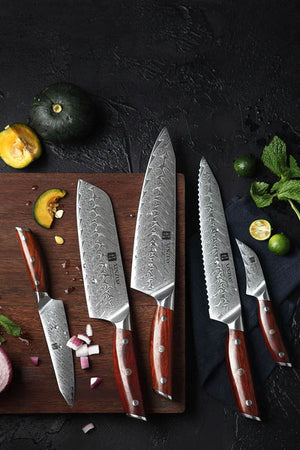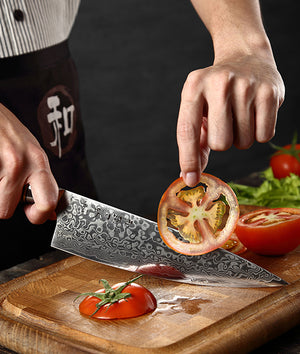
The Best Knives for Working with Fish
Cooking with fish is both wonderful and challenging at the same time – there’s so much you can do with it and so many delicious things you can create. But it requires great care and finesse in order to be able to make it both taste and look incredible. Fish needs the utmost care (some types of fish more than others), so if you’re going to be dealing with it, it’s essential that you’ve got the right tools to do so.
Arguably the most important thing to have is the right knife. Working with good, high-quality knives that are specifically designed for fish will allow you to treat it with the utmost care and respect – because when it comes to fish, it’s all about being gentle.
Now, while there are a few different types of knives that are perfect for dealing with fish, it’s a few specific qualities about them that stand out, making them so good at what they do.
We’re going to dive into why fish is different to other types of meat, why special knives are important, the most important qualities of fish knives, and, most importantly, our recommendations for the best types of knives for working with fish.
Why is Fish Different to Everything Else?
Fish is actually quite different to other types of meat – it’s more delicate than poultry or red meat. And, it’s true – fish is, generally speaking, a lot more delicate, but why?
First, fish is generally lower in saturated fats than red meat and even poultry, making it significantly leaner. This means that it tends to cook more quickly than fattier types of meat.
Fish contain omega-3 fatty acids, which are known to be good for cardiac health – something that other types of meat don’t have. In addition, fish is also full of various vitamins and minerals, making it a very healthy source of protein. Finally, fish meat boasts quite different texture to other meats, it’s flakier (although different types of fish may vary).
All these things contribute significantly to making fish quite different to red meat an poultry, and so, unsurprisingly, that means you need to treat it very differently. You can’t cut it and handle it in the same way as more robust types of meat, because you’ll risk ruining it’s delicate texture and structure. Of course, you can’t cook it in the same way either, but today, our focus is on preparation.
The moral of the story is that fish meat is vastly different to other types of meat, so, when you’re preparing it – filleting, cutting, slicing, whatever – that needs to be a major consideration.
But, what does it mean to treat fish differently to other meats? Well, on the one hand, it’s all about technique – something we’re not going to get into today. However, the other most important thing that we want to tell you about is the tools you use – how using the right knives will go a long way in helping you treat fish with the care, precision, and respect it deserves.
First, let’s talk about the qualities of fish knives that set them apart from other types of knives.
What Sets Fish Knives Apart from Other Types of Knives?
Although there are a few types of knives that are ideal for working with fish, and they can differ quite a lot, there are a few qualities that they have in common, as we mentioned earlier. Let’s talk about the main things that fish knives have in common that set them apart from other knives, and why they’re important.
- Sharpness of the Blade: Arguably most important of all is the sharpness of the blade. Now, this isn’t necessarily unique to fish – you’re also going to want a sharp blade for cutting precise slices of other types of meat. But it’s even more important with fish because the meat is so much more delicate. That means it’s easier to mess it up, and it’s more difficult to produce beautiful, clean slices. But, if it’s super sharp, you’ll be able to slice through it like butter.
- Blade Width: It’s important that fish knives have narrow blades, because this allows you to cut close to the skin – this prevents wastage and allows you to produce beautifully precise fillets.
- Flexibility of the Blade: The flexibility of the blade is also really important for precision, and it helps you work around the skin and the shape of the fillets. I blade that’s too robust won’t be as forgiving.
- Sturdy Handle: It’s always good to have a solid grip, but this is especially true for fish knives, because fish is significantly more slippery than other things. So, a good solid handle that allows you to have a firm grip is important to help you treat fish mat with care.
So, while different types of fish knives will vary in many ways – such as their shape, size, and so on – these are the things that tend to hold true for most, if not all, fish knives.
The Best Types of Knives for Working with Fish
As we’ve already mentioned, there are a few knives that are specifically designed to work well with fish, and they boast the qualities we spoke about above. So, what are they?
Here are our top four recommended knives for working with fish.
Fileting Knife
As the name suggests, a fileting knife is a fish knife that is specifically designed for the purpose of fileting. Here are some of the most important characteristics of the blade:
- Design and Shape: The blade is normally fairly thin and narrow, which allows it to be able to fillet and remove skin precisely. This is also helpful when it comes to cutting along fish bones.
- Length: The length of the blade can vary, but normally, they’re between six and nine inches long.
- Blade Flexibility: Flexibility is important for navigating around bones and following the natural curves of the fish. But, you don’t want it to be too flexible – moderately flexible is ideal.
- Sharpness: Fileting knives need be super sharp in order to be able to make clean cuts. That means that regular honing and occasional sharpening are essential for edge retention.
- Maintenance: Fish fileting knives are specialized, so much like any other high-quality tool, they need to be cleaned, dried, and stored carefully. That means, preferably, no dishwashing, storage that prevents bumping of knives, and regular honing, as we said.
- Material: Blade materials may vary, but one of the top choices for a fileting knife is high-carbon stainless steel, mostly because they’re so super sharp.
The most important feature of the handle of a fileting knife is that it provides you with a secure grip. They’re normally made from things like rubber, plastics, or wood.
Sashimi Knife
A sashimi knife, sometimes referred to as a sushi knife, is a Japanese-style knife that is ideal for slicing raw fish – as we said, for making sushi or, obviously, sashimi. It’s sometimes known as a “Hocho” or a “Yanagiba”.
These are some of the most important characteristics of a sashimi knife blade:
- Length: The blades of sashimi knives are normally between eight and twelve inches long, and they often have a beveled edge, preventing slices of fish from sticking to the knife.
- Material: Normally made from high-carbon steel, ensuring exceptional sharpness and great edge retention.
- Flexibility: The blades of sashimi knives normally aren’t quite as flexible as fileting knives, but they still boast slight flexibility, allowing for smooth, controlled slices of delicate fish.
- Maintenance and Care: Regular honing and occasional sharpening are essential for edge retention. Handwashing is preferred, as well as immediate drying and isolated storage (that is, nowhere it can be bumped).
Since sashimi knives are Japanese in style, they often have traditional Japanese-style wooden handles that are lightweight and easy to grip. Western variations may have slightly different, more modern style handles, but they all boast ergonomical grip.
Kirtitsuke Knife
Kiritsuke knives are super versatile, Japanese-style knives that feature characteristics of both Yanagiba knives and Usuba knives.
Here’s what you need to know about the main characteristics of a Kiritsuke knife blade:
- Shape and Design: Unique profile with a straight edge (straighter than a chef’s knife) and a pointed tip. They often have a slight upward curve, which is ideal for efficient chopping, slicing, and push cutting.
- Length: This can vary, but the blades are normally between eight and ten inches long.
- Material: Generally made from high-quality materials with a high carbon content, ensuring sharpness, great edge retention, and easy sharpening.
- Either Single or Double Bevel: Normally, traditional Japanese Kiritsuke knives have a single bevel, while modern western variations may have a double bevel.
- Versatility: Due to its design, a Kiritsuke knife is actually very versatile and can be used for precision work and general slicing and dicing.
The handle of a Kiritsuke knife is normally made from traditional Japanese-style wood in typical Japanese design, but there are also modern Western variations too. Regardless of the style, all grips are ergonomically designed for comfort and secure grip.
Sakimaru Knife
A Sakimaru knife is easy to identify by its striking design – its origins are Japanese, usurpingly, and it resembles a traditional Katana (Japanese sword). It’s also commonly associated with a sushi-making toolkit.;
Here’s what makes a Sakimaru knife blade what it is:
- Shape and Design: It has a very distinctive rounded, or semi-circular, tip that looks like a reverse tanto blade. This enhances precision and control while making intricate cuts.
- Length: A Sakimaru is normally between eight and ten inches long, which provides a lot of surface area for completing various tasks in both sushi and sashimi preparation.
- Material: Once again, like other fish knives, the blade is normally made from either carbon or high-carbon steel foor exceptional sharpness and edge retention.
- Single Bevel: Sakimaru knives are single beveled, which means that they have one beveled side and one flat side, contributing to precision.
- Maintenance and Care: Like other specialized knives, Sakimaru knives benefit from occasional sharpening and regular honing. They’re best handwashed, immediately dried, and stored on a knife magnet, if possible.
Sakimaru knife handles tend to made from wood and boast traditional Japanese design. However, there are also western versions these days, like most other knives. Either way, the handles are designed with a secure grip and comfort in mind.
To help you protect and maintain your knives and bring more beauty to your kitchen, check out our knife friendly Cutting Boards, Knife Blocks, Magnetic Knife Holders, Honing Rods & Whetstones.


